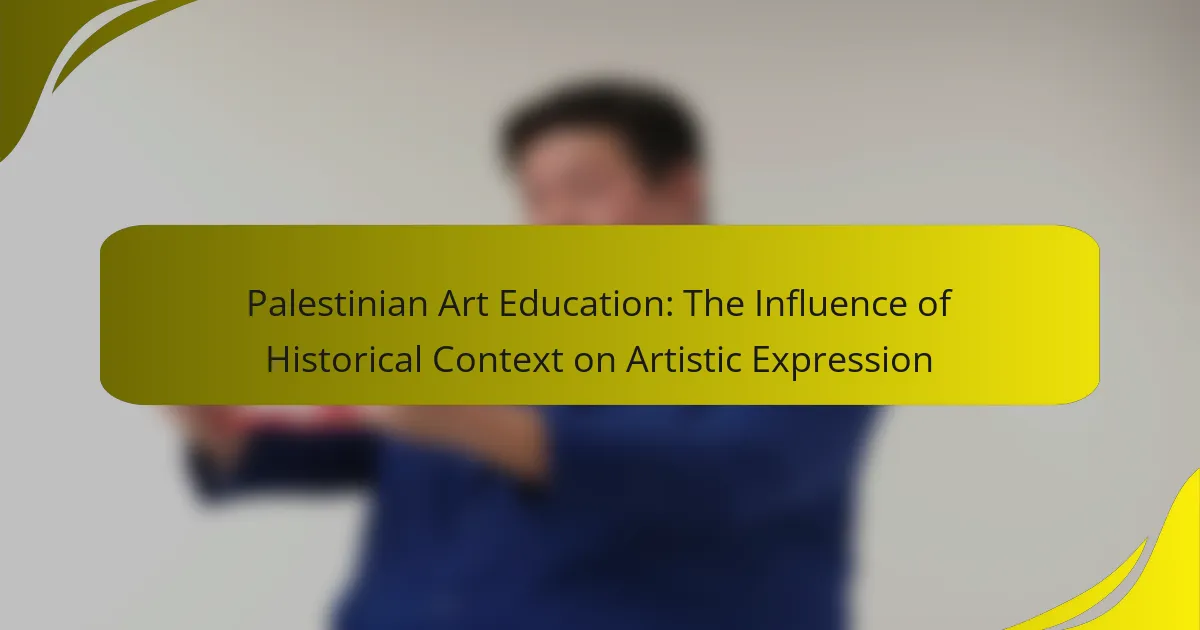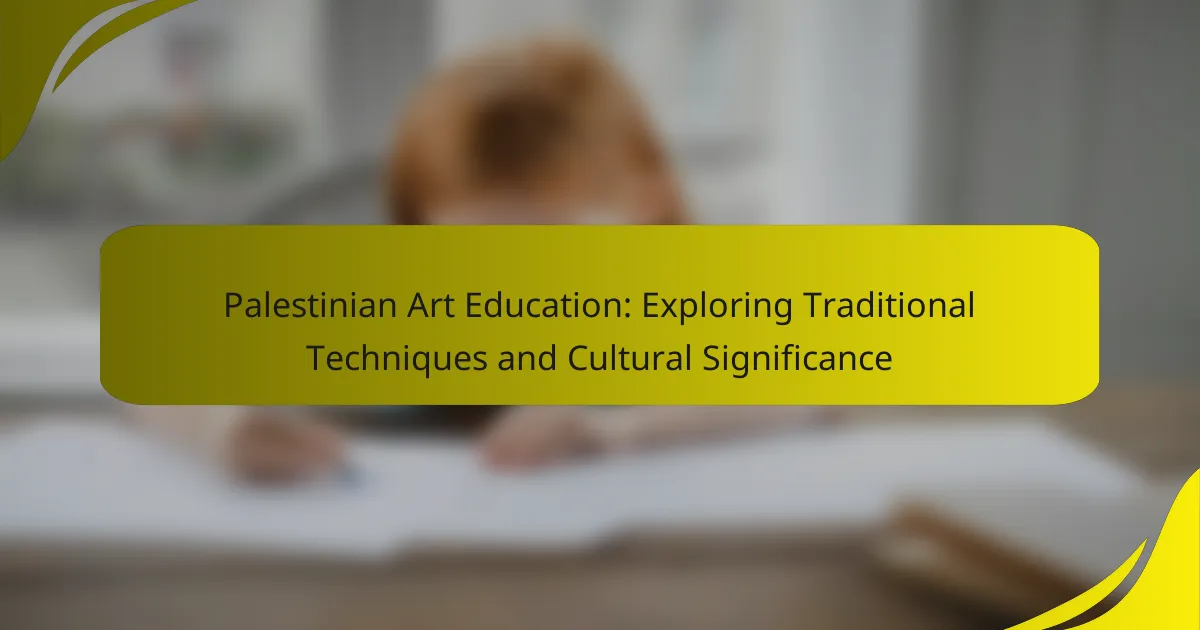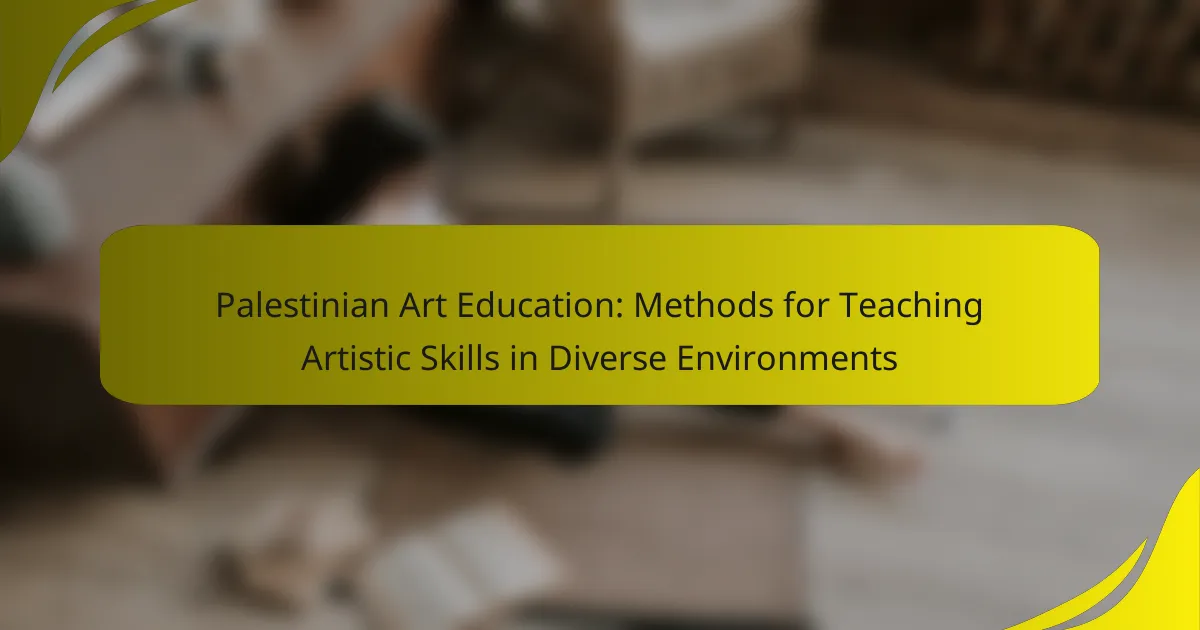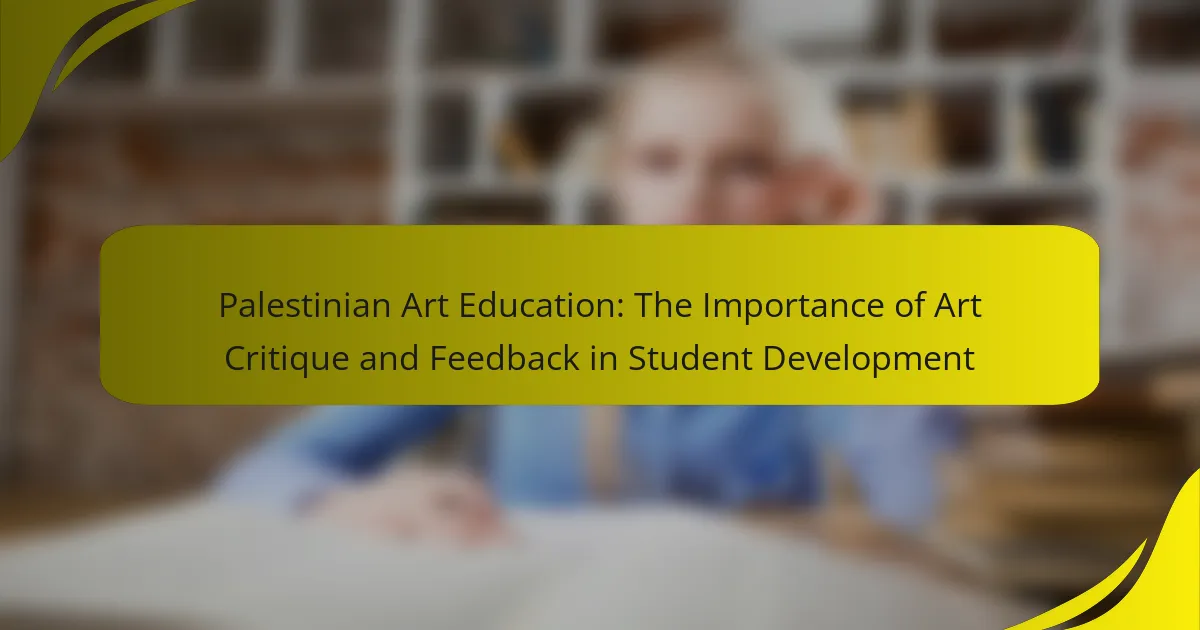Palestinian Art Education encompasses the teaching and learning of various artistic practices, including visual arts, performance, and crafts, within the Palestinian context. This educational framework integrates cultural heritage and contemporary issues, fostering creative expression and critical thinking among students. Emphasizing mixed media techniques, Palestinian Art Education allows for diverse artistic exploration, enabling students to reflect their identity and societal challenges through their work. The approach enhances student engagement by connecting them to their history and cultural narratives, ultimately empowering the next generation of Palestinian artists. Notable organizations and initiatives support this educational landscape, providing essential resources and platforms for artistic development.
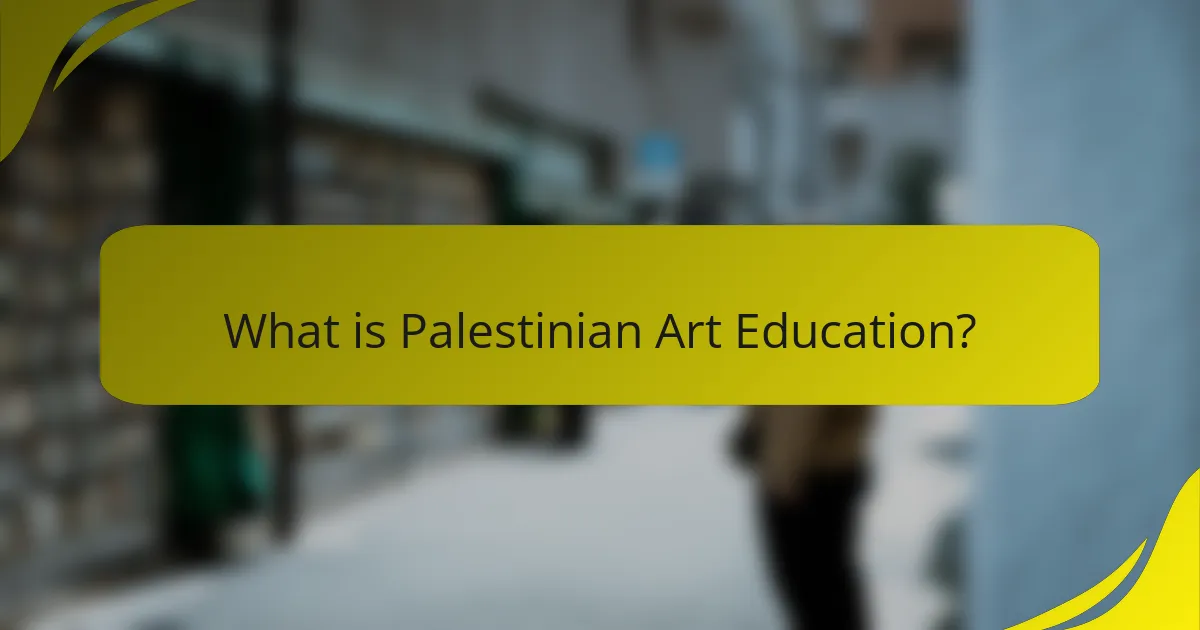
What is Palestinian Art Education?
Palestinian Art Education refers to the teaching and learning of art within the Palestinian context. It encompasses various artistic practices, including visual arts, performance, and crafts. This education often integrates cultural heritage and contemporary issues faced by Palestinians. Institutions and programs aim to nurture creative expression and critical thinking. Palestinian Art Education emphasizes the use of mixed media to reflect identity and resistance. It plays a crucial role in preserving cultural narratives and fostering community engagement. Notable organizations and initiatives support this educational framework, providing resources and platforms for artists and students.
How has Palestinian Art Education evolved over time?
Palestinian Art Education has evolved significantly over time, reflecting historical, social, and political changes. Initially, art education in Palestine focused on traditional forms and techniques, often tied to cultural heritage. In the late 20th century, the impact of conflict and displacement led to a shift towards contemporary art practices. This evolution included the incorporation of mixed media, allowing artists to express complex narratives. Institutions such as the International Academy of Art Palestine were established to promote diverse artistic expressions. Additionally, community workshops and grassroots initiatives emerged, fostering creativity among youth. Today, Palestinian Art Education emphasizes critical thinking and social engagement through art. This transformation illustrates the resilience and adaptability of Palestinian artists and educators in response to their environment.
What historical events have influenced Palestinian Art Education?
The historical events that have influenced Palestinian Art Education include the Nakba of 1948 and the subsequent Israeli occupation. The Nakba resulted in the displacement of many Palestinians, leading to a loss of cultural heritage. This event sparked a need for art as a form of resistance and identity preservation. The Israeli occupation, beginning in 1967, further restricted access to resources and education. These restrictions prompted artists and educators to innovate using mixed media. The First and Second Intifadas also played a significant role by fostering a sense of community and activism through art. These events collectively shaped a unique artistic expression that reflects Palestinian struggles and resilience.
How do cultural narratives shape Palestinian Art Education?
Cultural narratives significantly shape Palestinian Art Education by influencing themes, techniques, and perspectives taught in art curricula. These narratives reflect the historical and socio-political context of Palestine, informing artists’ identities and expressions. Art educators incorporate stories of resilience, displacement, and cultural heritage into their teaching. This approach fosters a deeper understanding of the Palestinian experience among students. For instance, the use of traditional motifs and contemporary issues in artworks illustrates the blend of past and present. Additionally, cultural narratives encourage critical thinking about identity and representation in art. Overall, they create a framework for students to explore their cultural roots while engaging with global artistic conversations.
What role does mixed media play in Palestinian Art Education?
Mixed media plays a significant role in Palestinian art education by fostering creativity and expression. It allows students to combine various materials and techniques, enhancing their artistic skills. This approach encourages experimentation, which is essential for developing unique artistic voices. Mixed media also reflects the diverse cultural heritage of Palestine. It integrates traditional and contemporary elements, making art education more relevant to students’ identities. Additionally, mixed media serves as a tool for social commentary. It enables artists to address political and social issues within their community. By engaging with mixed media, students gain a deeper understanding of their cultural context. This educational method promotes critical thinking and innovation in artistic practices.
How is mixed media defined within the context of Palestinian art?
Mixed media in Palestinian art is defined as the combination of various artistic materials and techniques. This approach allows artists to express complex narratives and cultural identities. It often includes elements such as painting, collage, photography, and textiles. Palestinian artists use mixed media to reflect their experiences and heritage. This technique enhances the emotional depth of their work. It also serves as a form of resistance and commentary on sociopolitical issues. The use of mixed media is prevalent in contemporary Palestinian art. Artists like Emily Jacir and Khaled Jarrar exemplify this method in their artworks.
What are the common materials used in mixed media art by Palestinian artists?
Common materials used in mixed media art by Palestinian artists include paper, fabric, and paint. Artists often incorporate found objects and natural materials as well. These materials reflect the cultural heritage and social issues prevalent in Palestine. For instance, traditional textiles are frequently used to symbolize identity. Additionally, recycled materials emphasize sustainability and resourcefulness. The use of diverse materials allows for rich, layered expressions in their artwork. This approach showcases the complexity of Palestinian narratives and experiences.
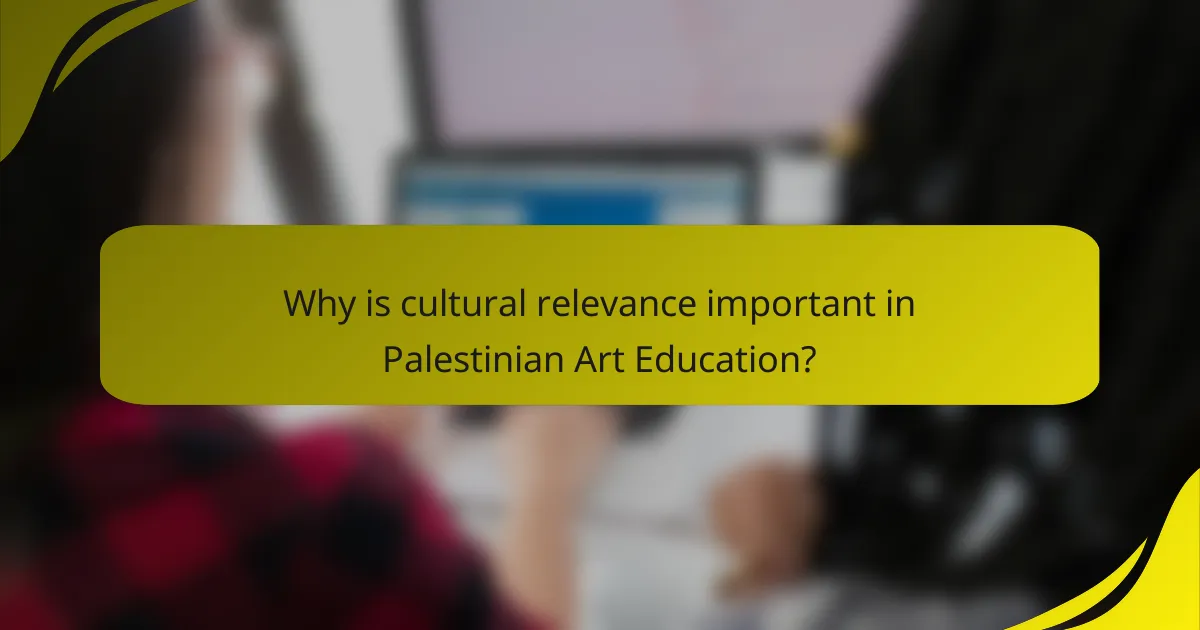
Why is cultural relevance important in Palestinian Art Education?
Cultural relevance is crucial in Palestinian art education as it fosters identity and heritage. It allows students to connect with their history and cultural narratives. Engaging with local traditions promotes a sense of belonging. This relevance enhances the educational experience by making learning more relatable. Studies show that culturally relevant pedagogy improves student engagement and performance. Art serves as a medium for expression and resistance, reflecting societal issues. Incorporating cultural elements validates students’ experiences and perspectives. This approach ultimately empowers the next generation of Palestinian artists.
How does cultural identity influence artistic expression in Palestinian Art Education?
Cultural identity significantly influences artistic expression in Palestinian Art Education. This influence is evident in the themes, techniques, and materials used by artists. Palestinian artists often incorporate symbols and motifs that reflect their heritage and experiences. For instance, traditional patterns and colors are prevalent in their works. This connection to cultural identity fosters a sense of belonging and community among artists and students. Additionally, art serves as a medium for expressing social and political narratives unique to Palestinian society. Studies show that art education that embraces cultural identity enhances creativity and critical thinking among students. By integrating cultural context, educators provide a richer learning experience that resonates with students’ lives.
What themes are prevalent in Palestinian mixed media art?
Prevalent themes in Palestinian mixed media art include identity, resistance, and displacement. Artists often explore the complexities of Palestinian identity through personal and collective narratives. Resistance against occupation is a significant theme, symbolizing resilience and hope. Displacement is frequently depicted, reflecting the historical and ongoing experiences of Palestinians. Additionally, cultural heritage and memory are central, showcasing traditional motifs and stories. The interplay of these themes creates a rich dialogue about the Palestinian experience.
How do artists convey cultural stories through mixed media?
Artists convey cultural stories through mixed media by integrating various materials and techniques. This approach allows for a richer expression of cultural narratives. Mixed media combines traditional and contemporary methods, enhancing storytelling. For instance, Palestinian artists use fabric, paint, and found objects to represent their heritage. This fusion of elements reflects the complexity of their cultural identity. Historical events and personal experiences often inform the content of these artworks. By utilizing mixed media, artists can engage viewers on multiple sensory levels. This technique also encourages dialogue about cultural themes and social issues.
What challenges do educators face in teaching Palestinian Art?
Educators face several challenges in teaching Palestinian Art. Limited resources hinder access to materials and tools necessary for art education. Political instability affects the learning environment and restricts field trips or exhibitions. Cultural sensitivity is crucial, as educators must navigate complex historical narratives. Additionally, varying levels of student engagement can complicate lesson delivery. Lack of trained educators in Palestinian Art diminishes the quality of instruction. Finally, societal perceptions of art may undervalue its importance in education. These factors collectively impact the effectiveness of teaching Palestinian Art in educational settings.
How do political and social issues impact art education in Palestine?
Political and social issues significantly impact art education in Palestine. Ongoing conflict and instability limit resources for educational institutions. Restricted movement affects students’ access to art supplies and facilities. Censorship and surveillance can stifle creative expression in art curricula. Additionally, social issues such as poverty hinder families’ ability to support arts education. Cultural identity plays a crucial role, as art becomes a means of resistance and expression. The curriculum often incorporates themes of struggle and resilience, reflecting the socio-political landscape. These factors collectively shape the nature and delivery of art education in Palestinian contexts.
What resources are available for educators in Palestinian Art Education?
Educators in Palestinian Art Education have access to various resources. These include online platforms that offer lesson plans and teaching materials. Organizations such as the Palestinian Art Academy provide workshops and training for teachers. Local art galleries often host exhibitions and educational programs. Additionally, community centers may offer art classes that focus on Palestinian culture. Educational institutions in the region may provide access to libraries with relevant art history texts. Online forums and social media groups also facilitate collaboration among educators. These resources collectively enhance the teaching of Palestinian art and culture.
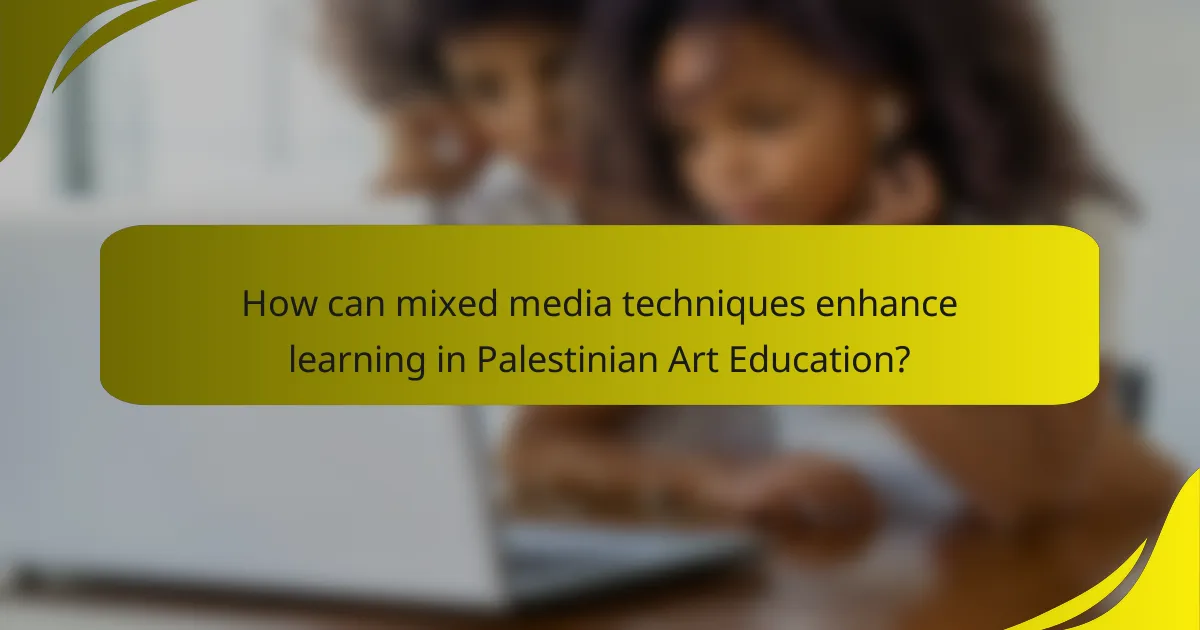
How can mixed media techniques enhance learning in Palestinian Art Education?
Mixed media techniques can enhance learning in Palestinian Art Education by fostering creativity and self-expression. These techniques encourage students to combine various materials, such as paint, fabric, and found objects. This approach allows for diverse artistic exploration and innovation. Students can express their cultural identity and experiences through unique artworks. Research indicates that mixed media promotes critical thinking and problem-solving skills. It also engages students in collaborative projects, enhancing their teamwork abilities. By integrating local materials and themes, mixed media connects students to their heritage. This relevance to Palestinian culture deepens their understanding and appreciation of their artistic traditions.
What are effective mixed media techniques used in Palestinian Art Education?
Effective mixed media techniques used in Palestinian Art Education include collage, assemblage, and printmaking. Collage combines various materials such as paper, fabric, and photographs. This technique allows students to express their cultural identity creatively. Assemblage involves creating 3D artworks from found objects. It encourages resourcefulness and innovation among students. Printmaking techniques, like linocut or screen printing, enable reproducible art forms. These methods foster collaboration and community engagement. Mixed media techniques in Palestinian art often reflect historical and social narratives. They provide a platform for dialogue and cultural expression.
How can students integrate different materials in their artworks?
Students can integrate different materials in their artworks by combining various textures and forms. They can use paint, fabric, paper, and found objects to create mixed media pieces. This approach enhances creativity and visual interest. Students may layer materials to add depth to their work. They can also experiment with techniques like collage and assemblage. Incorporating local cultural elements can provide context and meaning. This method encourages personal expression and storytelling. Research shows that mixed media fosters innovation in art education, promoting critical thinking and problem-solving skills.
What skills can students develop through mixed media projects?
Students can develop various skills through mixed media projects. These skills include creativity, as they combine different materials and techniques. They also enhance critical thinking by analyzing how various elements interact. Additionally, mixed media projects improve problem-solving abilities through experimentation. Students gain technical skills in handling diverse art materials. Collaboration skills are fostered when working in groups on projects. Communication skills are developed as students present their work. Time management skills are also improved by meeting project deadlines. These skills are essential for personal and professional growth in the arts.
What best practices can educators adopt for teaching mixed media in Palestinian Art?
Educators can adopt several best practices for teaching mixed media in Palestinian Art. First, they should integrate local cultural narratives into their lessons. This approach helps students connect personally with the art forms. Second, providing hands-on workshops allows students to experiment with various materials. This fosters creativity and encourages self-expression. Third, incorporating historical context enriches students’ understanding of the significance of mixed media in Palestinian culture. Fourth, collaboration with local artists can provide real-world insights and inspiration. Fifth, utilizing technology can enhance learning experiences. Digital tools can help students create and share their artwork. Lastly, encouraging reflection on their work promotes critical thinking and personal growth. These practices not only enhance artistic skills but also deepen cultural appreciation.
How can collaborative projects enrich the learning experience in art education?
Collaborative projects can significantly enrich the learning experience in art education. They foster teamwork and communication skills among students. Engaging in group activities encourages the exchange of diverse ideas. This interaction can lead to innovative artistic expressions. Collaborative projects also allow students to learn from each other’s strengths. They can explore different techniques and perspectives together. Research shows that collaboration enhances critical thinking skills. A study published in the Journal of Art Education found that students involved in collaborative projects reported higher satisfaction and engagement levels.
What assessment methods work best for evaluating mixed media artworks?
The best assessment methods for evaluating mixed media artworks include visual analysis, peer reviews, and reflective critiques. Visual analysis involves examining the composition, color, and texture of the artwork. This method helps identify the techniques and materials used in the piece. Peer reviews allow fellow artists or students to provide feedback based on their interpretations. This fosters a collaborative learning environment. Reflective critiques encourage artists to articulate their creative process and the meaning behind their work. This method enhances self-awareness and critical thinking. These assessment methods are effective in capturing the complexity and cultural significance of mixed media artworks in the context of Palestinian art education.
What resources can support educators in Palestinian Art Education?
Resources that can support educators in Palestinian Art Education include community art centers, online platforms, and educational workshops. Community art centers often provide access to materials and expert guidance. Online platforms like YouTube host tutorials that focus on Palestinian art techniques. Educational workshops can offer hands-on experience and cultural insights. Organizations such as the Palestinian Art Court provide resources and exhibitions to enhance art education. Additionally, local universities may offer courses on Palestinian art history and contemporary practices. These resources collectively enrich the educational experience for both educators and students in this field.
Palestinian Art Education encompasses the teaching and learning of art within the Palestinian context, integrating cultural heritage and contemporary issues. This article explores the evolution of Palestinian Art Education, highlighting its response to historical events and the significance of mixed media as a tool for creative expression and social commentary. Key themes include cultural narratives, the role of mixed media techniques, and the challenges faced by educators in promoting artistic engagement. Additionally, it addresses the importance of cultural relevance in art education and the skills developed through mixed media projects. Resources available for educators and best practices for teaching mixed media in this context are also discussed.
